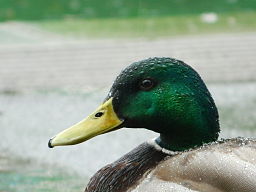The Difference Between a Mallard and a Duck
When asking yourself “What’s the difference between a mallard and a duck?”, it’s like asking the difference between a dog and a Rottweiler, a bird and a canary or a snake and a python. A mallard is a type of duck. Let’s compare the two a little more closely;
DUCKS
There are over 120 different species of ducks. Ducks are primarily aquatic birds, like geese, and live around both salt and fresh water. Ducks live all over the world with the exception of Antarctica. Some duck species are migratory. This is true particularly of ducks living in the Northern Hemisphere. Tropical ducks will generally not seasonally migrate. Most ducks stay around the same living area (pond, park, etc.), however, if their habitat is subject to droughts or similar seasonal changes, they will adapt a more nomadic lifestyle.
Ducks make many different sounds, ranging from a low, grunting quack to a high pitched whistling sound. Most male ducks are quiet and very few actually “quack.” Instead, their calls may include squeaks, chirps, grunts, groans, whistles, and growls. All ducks have highly waterproof feathers. This is due to their elaborate feather arrangement and a waxy layer that is spread onto each feather when grooming (preening).When they dive underwater, their under layer of feathers remains dry.
Ducks have a variety of feeding methods and prey items including; grasses and aquatic plants, fish, amphibians, worms, molluscs and insects. Dabbling ducks skim the surface of the water and rarely dive whereas diving and salt water ducks find their food deep underwater. A few species even catch and swallow large fish as a part of their feeding habits. Some ducks have a wide flat beak meant to dredge. This is used to pull worms and molluscs from mud, swallow amphibians and pull up weeds.
In general, ducks are monogamous. Usually they will only be coupled for a single year but some larger species will form bonds that last for a larger number of years. There are many duck species that display sexual dimorphism. This means that the males and females have different appearances.
MALLARD
Mallards are probably the most popular species of duck in North American and Eurasian wetlands, parks and ponds. This is a sexually dimorphic species of duck. This means that the males and females look different from one another. Male mallards sport bright green heads and are easily identified. The females are a brown color, not without their own subtle beauty. Both males and females have a blue patch in their wing. Mallards make the popular “quack” sounds that most people associate to the sound of a duck. Female mallards are particularly vocal.
You’ll find them close to ponds, marshes, streams, and lakes. Here they feed on plants, invertebrates, fish, and insects. Mallards feed by tipping their beak forward and nibbling on underwater plants and weeds, they don’t dive like other duck species. They also forage and graze for food on land. Mallards are often seen mingling with other species of duck in city ponds and waterfronts. The majority of domesticated ducks came from mallards. This species is also commonly hunted for food.
Mallards, in general, are monogamous. They will form pairs long before the breeding season in spring. Courtship can be witnessed all winter long while pairing happens in autumn. Only the females incubate the eggs and care for ducklings.
SUMMARY
-
There are over 120 species of ducks. A mallard is just one type of duck.
-
Ducks can have different life habits (migratory, nomadic, sedentary)
-
All ducks have waterproof feathers
-
Ducks consume a variety of foods and prey (plant matter, insects, mollusks, fish and amphibians).
-
Ducks can be a range of feeding types, from filter feeders to divers to dredgers. Mallards are “dabbling”, or surface feeding, ducks.
-
Most ducks are monogamous, with relationships lasting 1 year or longer
-
Many species of duck, including the Mallards, are sexually dimorphic
-
Mallards are the ancestors to most of the domestic birds we keep today
-
Ducks vary in sizes and colouration. Mallards have specific colouration. The male has a bright green head while the females are a dabbled brown.
-
Ducks have different vocalizations, varying between low to high pitched quacks.
- Difference Between Vascular Cambium and Cork Cambium - November 1, 2023
- Difference Between DevOps and Developer - September 10, 2023
- Difference Between Acute Gastritis and Chronic Gastritis - April 3, 2023
Search DifferenceBetween.net :
1 Comment
Leave a Response
References :
[0]http://www.allaboutbirds.org/guide/mallard/id
[1]http://en.wikipedia.org/wiki/Duck
[2]http://commons.wikimedia.org/wiki/File%3AMallard_Duck.JPG
[3]http://commons.wikimedia.org/wiki/File:Bernache.jpg#mediaviewer/File:Bernache.jpg


Apparently Google does NOT know all